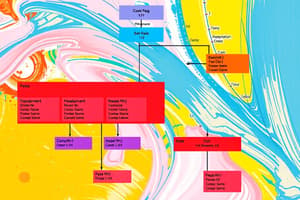Podcast
Questions and Answers
What is the highest closing price recorded on January 4th, 1990?
What is the highest closing price recorded on January 4th, 1990?
- 24.56
- 24.35
- 24.84 (correct)
- 25.06
Which of the following SQL commands correctly retrieves all rows from the IBM table?
Which of the following SQL commands correctly retrieves all rows from the IBM table?
- RETRIEVE ALL FROM IBM;
- SELECT * FROM IBM; (correct)
- GET * FROM IBM;
- FETCH * FROM IBM;
In the relational database structure of Options.sqlite, which table contains information about stock trades?
In the relational database structure of Options.sqlite, which table contains information about stock trades?
- Options
- Stock
- StockTrades (correct)
- OptionContracts
What is the primary key that connects the Stock and StockTrades tables in the Options.sqlite database?
What is the primary key that connects the Stock and StockTrades tables in the Options.sqlite database?
What type of relationships exist between the tables of the Options.sqlite database?
What type of relationships exist between the tables of the Options.sqlite database?
Which date has the lowest recorded open price from the provided data?
Which date has the lowest recorded open price from the provided data?
What is the purpose of the foreign key in the StockTrades table?
What is the purpose of the foreign key in the StockTrades table?
Which of the following values represents the volume of trades on January 8th, 1990?
Which of the following values represents the volume of trades on January 8th, 1990?
What type of file extension is used for SQLite databases?
What type of file extension is used for SQLite databases?
What is the purpose of the validation table in the Finance.sqlite database?
What is the purpose of the validation table in the Finance.sqlite database?
Which SQL statement is used to create the Prices table in the SQLite database?
Which SQL statement is used to create the Prices table in the SQLite database?
When inserting data into the Prices table, which data type is used for the Price field?
When inserting data into the Prices table, which data type is used for the Price field?
What does the fetchall method return after querying the Prices table?
What does the fetchall method return after querying the Prices table?
Which of the following stocks is NOT included among the tables in the Finance.sqlite database?
Which of the following stocks is NOT included among the tables in the Finance.sqlite database?
What does the SQLite database engine claim about its deployment?
What does the SQLite database engine claim about its deployment?
What is a characteristic feature of SQLite as mentioned in the content?
What is a characteristic feature of SQLite as mentioned in the content?
What defines a relationship as many-to-many in a database?
What defines a relationship as many-to-many in a database?
Which statement correctly describes foreign keys in a database schema?
Which statement correctly describes foreign keys in a database schema?
What is the main purpose of normalization in database design?
What is the main purpose of normalization in database design?
Which normal form ensures that a table has no partial dependencies?
Which normal form ensures that a table has no partial dependencies?
What does a schema in database terms primarily define?
What does a schema in database terms primarily define?
What is required to establish a one-to-many relationship in a database?
What is required to establish a one-to-many relationship in a database?
What is typically done to ensure integrity constraints in a database schema?
What is typically done to ensure integrity constraints in a database schema?
How is a linking table used in a many-to-many relationship?
How is a linking table used in a many-to-many relationship?
What type of relationship exists between the Stock and OptionContracts tables?
What type of relationship exists between the Stock and OptionContracts tables?
Which SQL statement is primarily used to retrieve data from a database?
Which SQL statement is primarily used to retrieve data from a database?
What does DML stand for in SQL?
What does DML stand for in SQL?
Which of the following correctly describes a DDL operation?
Which of the following correctly describes a DDL operation?
Which SQL commands are included under Data Control Language (DCL)?
Which SQL commands are included under Data Control Language (DCL)?
What is a common application of SQL in quantitative trading or risk management systems?
What is a common application of SQL in quantitative trading or risk management systems?
What distinguishes Transact-SQL from standard SQL?
What distinguishes Transact-SQL from standard SQL?
Which of the following best describes what a SELECT statement does?
Which of the following best describes what a SELECT statement does?
Which clause is essential in a SELECT statement?
Which clause is essential in a SELECT statement?
What must separate multiple columns in the SELECT statement?
What must separate multiple columns in the SELECT statement?
How is SQL case sensitivity characterized?
How is SQL case sensitivity characterized?
What symbol is used to select all columns from a table?
What symbol is used to select all columns from a table?
Which operator is used to filter rows by checking for equality in the WHERE clause?
Which operator is used to filter rows by checking for equality in the WHERE clause?
What does the BETWEEN operator do in a SQL query?
What does the BETWEEN operator do in a SQL query?
What is the correct way to terminate an SQL statement in most databases?
What is the correct way to terminate an SQL statement in most databases?
In a SELECT statement, which clause helps to filter results based on specific conditions?
In a SELECT statement, which clause helps to filter results based on specific conditions?
Study Notes
Relationships between tables
- Relationships occur when a primary key in one table matches a foreign key in another table.
- Foreign keys can have null or duplicate values, and they reference primary keys in other tables.
- One-to-one: A single record in the first table corresponds to a single record in the second table, and vice versa.
- One-to-many: A single record in the first table can be related to multiple records in the second table, but a single record in the second table can only correspond to one in the first.
- Many-to-many: A single record in the first table can be related to multiple records in the second table, and vice versa. A linking table is created to handle this relationship by copying the primary keys from each table into the new table.
Database Schema and Integrity
- A schema defines the database structure, including tables, fields, relationships, etc.
- Integrity constraints ensure compatibility between various components of the schema.
- Formulas within a schema can represent integrity constraints for specific applications.
Normalization
- A process of optimizing database schemas to minimize redundancies and issues with data insertion, deletion, and updating.
- A complex schema is often decomposed into smaller schemas for optimization.
- Normal forms (at least five exist) are sets of rules that assess table structure for soundness and error-free designs.
SQLite
- SQLite is an open-source, self-contained, serverless, zero-configuration, SQL database engine.
- It is widely deployed and stores data directly in disk files with an .sqlite extension.
- Python can create and access SQLite databases.
Finance.sqlite
- This database holds daily historical price data for 13 stocks and the S&P 500.
- Data tables are named after their corresponding tickers (e.g., AXP, GE, IBM, etc.).
- A Tickers validation table contains a single column (Symbols) listing the unique ticker symbols.
Options.sqlite
- This database utilizes a relational structure to store information about stocks, options, and related trades.
- It consists of four tables: Stocks, OptionContracts, StockTrades, and OptionTrades.
- Relationships are established through primary and foreign keys (e.g., StockSymbol in the Stock table and the StockTrades table).
- The relationships in this database are all one-to-many.
Structured Query Language (SQL)
- SQL is a standardized language for database communication and interaction, designed to be cross-platform.
- Database vendors often extend ANSI/ISO SQL with their own versions (e.g., Transact-SQL, PL/SQL).
- Python can embed SQL statements, enabling various database operations from data retrieval to structural changes.
SQL Statement Categories
- Data Query Language (DQL): Used for data retrieval.
- Data Manipulation Language (DML): Used for writing, changing, or deleting data.
- Data Definition Language (DDL): Used to modify the database structure.
- Data Control Language (DCL): Involves commands like GRANT and REVOKE, which control access privileges.
DML (Data Manipulation Language)
- SELECT: The primary command used to retrieve data from a database.
- SELECT Statement Clauses:
- FROM: Required clause specifying the table to query.
- WHERE: Used to filter results based on specific conditions.
- ORDER BY: Used to sort the returned results.
- GROUP BY: Used to group rows with the same values based on specified columns.
- HAVING: Used to filter grouped results.
- Comparison Operators:
<: Less than.>: Greater than.>=: Greater than or equal to.=: Equals.<>: Not equal to.BETWEEN: To check if the value lies within a specified range.
Studying That Suits You
Use AI to generate personalized quizzes and flashcards to suit your learning preferences.
Related Documents
Description
This quiz explores the concepts of table relationships within a database, including one-to-one, one-to-many, and many-to-many relationships. It also covers the importance of database schema and integrity constraints that maintain the consistency and validity of data. Test your knowledge and understanding of these fundamental database principles.




